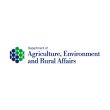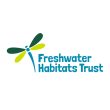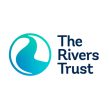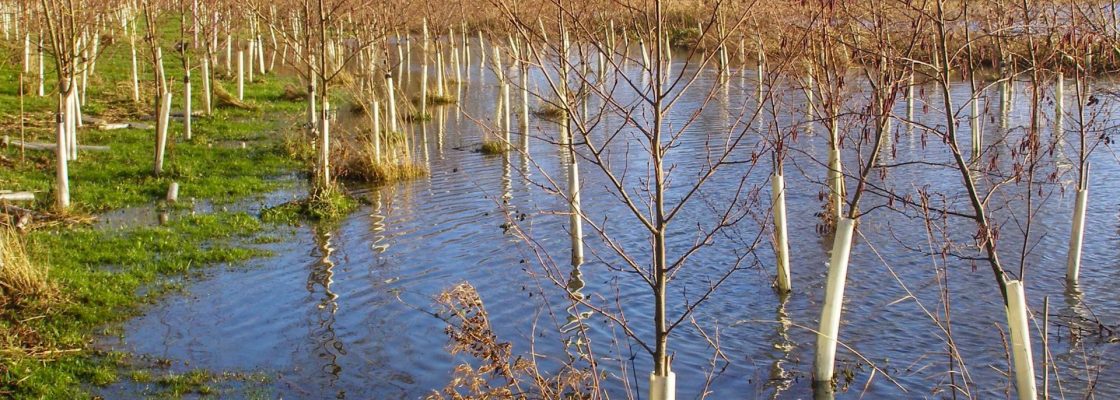Summary
Woodlands provide a wide range of environmental and societal benefits, including several related to water. Prominent among these are protecting water quality, reducing flood flows, and cooling streams and rivers.
Forest Research has led a range of projects to increase knowledge about the water-related benefits of woodlands and to evaluate the costs and benefits of associated investments, including the Payments for Ecosystem Services (Forests for Water) COST Action, commonly referred to as PESFOR-W. This was an international research network that reviewed evidence on the ability of woodland creation to improve the freshwater environment, and on the governance and cost-effectiveness of woodlands for water payments for ecosystem services schemes.
The development of a Woodland Water Code (WWC) as a crediting mechanism to encourage private investment in trees for the improvement of the freshwater environment was a key action under the England Trees Action Plan (ETAP). An initial two-year project which aimed to develop a novel WWC that is applicable across the UK has now been completed. The project delivered a number of key outputs, principal among which are separate Excel-based calculators and guidance documents to quantify the water quality, flood alleviation and water shading benefits from woodland creation. These are supported by a detailed set of underpinning methods and rules governing their application, plus individual country-based target maps highlighting where woodland water benefits are most needed.
Successful delivery of Phase 1 led to securing funding to continue the development of the WWC. Work on Phase 2, “Validating Woodland Water Code metrics and methodologies” has now begun and will run until the end of March 2026. The main aim of the project extension is to deliver a verified, Version 1 of the WWC unit calculators, providing a standardised methodology for end users to predict the water benefits resulting from individual woodland creation schemes. The WWC team will be working with the Woodland Carbon Code, Soil Association and the WWC Steering and Technical Groups to ensure the WWC is robust, aligning with UK best practice and the BSI standards framework for UK nature markets.
Future work will aim to develop, or support the development of one or more private finance markets which utilise these unit calculators. If necessary, the unit calculators may be adapted to meet market needs.
This project is supported by the Nature for Climate Fund.
Research objectives
Woodland creation presents significant opportunities to help deliver a range of Defra policy goals, including the targets set out in the 25-Year Environment Plan for clean water and managing flood risk.
Current financial support undervalues the water-related benefits of woodland and falls short of delivering the required scale of land use change to achieve desired outcomes. The WWC addresses this gap by laying the foundation for monetising woodland water services and attracting greater private sector investment in woodland creation. This could bring about transformative change through increased woodland profitability, driving greater targeted planting by landowners to make a difference for the freshwater environment and communities impacted by flooding.
In delivering version 1 of the WWC, the current project will consider the following related research questions:
- How can WWC units and unit calculators be designed in a way that aligns with the requirements of end users?
- How can the WWC water quality methodology be utilised in Nutrient Mitigation to incorporate other diffuse pollutants?
- Can the approach for quantifying water benefits through the WWC be validated, and how can this process be streamlined e.g. through alignment with the WCC?
- Does the WWC unit calculator approach align with the latest UK Nature Market best practices?
- What are the strengths, weaknesses, opportunities and threats of a WWC to incentivise woodland creation?
Latest Update
Piloting of the flooding and water shading methods was undertaken with project partners in the latter stage of the first phase of the WWC project and the results are now in. These are being considered by the project team and informing next steps.
Planned work includes further testing and refining water metrics and methodologies, as well as the associated rules and target maps. A peer reviewed paper is also planned to document the methodologies and the underpinning evidence base. Close engagement with end user groups will be a key focus of the project to ensure the WWC unit calculator aligns with user needs across a range of contexts.
If you are interested in piloting the emerging WWC, please contact romany.vassell@forestresearch.gov.uk for more information.
Further information
Frequently asked questions (FAQs)
When will the WWC be available to use?
The aim of the Validating Woodland Water Code metrics & methodologies project is to deliver a Version 1 of the WWC unit calculator by March 2026. A briefing paper is planned to explore options for future implementation to best support UK water and green finance policies, which could include:
- Launched as a verified, voluntary, UK code, either standalone or as an add-on to the Woodland Carbon Code.
- Incorporating the WWC methodologies within alternative voluntary finance mechanisms.
- Separate adoption of the individual methods tailored to end user needs, such as the application of the water quality calculator by water companies seeking to manage pollutant loadings within water supply catchments (dependent on regulatory approval for the WWC).
- Application within compliance markets to meet planning policy requirements, such as offsetting impacts of nutrient loads to water as part of Nutrient Mitigation Schemes or managing flood risk within insurance markets.
Will the WWC be UK-wide?
The aim is to develop a UK-wide WWC. Representatives from all four devolved nations are on the project Steering Group, and discussions are ongoing to ensure the WWC is applicable across the UK.
What is a Woodland Water Unit?
Woodland Water Units will represent a new type of credit. They will be used to represent the quantified benefits provided by the created woodland for the three water elements included in the WWC (water quality, flood alleviation and water shading). The benefits will be quantified using bespoke tools, optimised for use by the WWC. Woodland Water Units will be complex compared to carbon credits which use a common metric (greenhouse gas equivalent). Work to determine the appropriate metrics, timing, scale and format of the water credits is ongoing.
How will good woodland management practices be enforced?
Woodland management practices will follow the United Kingdom Forestry Standard (UKFS) regarding all aspects such as woodland design, establishment and water protection. The Woodland Creation Sensitivity Map, ground truthing, Environment Impact Assessments (EIA) and other requirements will be followed before woodland is approved and Woodland Water Units are generated to ensure existing priority habitats and species are not affected.
Who are the buyers of Woodland Water Units?
Market research is currently underway to identify potential buyers of Woodland Water Units through the WWC. Buyers include any company or organisation looking to invest in woodland creation with an interest in delivering water benefits. Initial market research has indicated a particular interest from companies/ organisations:
- with a direct reliance on a supply of clean water (e.g. food and drinks industry and water companies);
- impacted by flooding (e.g. insurance and reinsurance companies, local authorities and local communities); and/ or
- involved in river restoration (e.g. Wildlife/ Rivers Trusts and Fishery Groups).
How are water resources considered?
It is recognised that woodland creation presents a potential disbenefit for water resources, depending on a wide range of factors. Consequently, water resources are not part of the WWC, but instead considered under the regulatory process for woodland creation projects. Vulnerable areas have been identified and will be excluded if woodland creation is assessed as likely to further exacerbate the issue.
The World Resource Institute (WRI) has developed a Volumetric Water Benefit Accounting method for implementing and valuing water stewardship activities. Whilst this method does include reforestation, it does not provide a standardised methodology for quantifying the impact of woodlands on water resources, or a private finance mechanism tailored to woodland creation in the UK – which is the focus of the WWC project.
Will the WWC be applicable for both voluntary and regulatory/compliance markets?
The WWC is expected to be a voluntary Code at the outset, aligning with the WCC. However, the methodologies underpinning the WWC could be utilised in other markets. For example, the WWC team are working with Natural England to ensure the approach is consistent with Nutrient Trading in England.
The project team are also liaising with contacts in the Welsh Government and Natural Resources Wales to ensure consistency with developments in Wales on nutrient neutrality. It is recognised that some water companies are already working with farmers to undertake nature-based solutions to tackle water quality issues – some involving tree planting (e.g. see case studies).
In these instances, the WWC may not be required as a vehicle for financing woodland creation schemes but could provide a consistent methodology for assessing the water benefits for reporting purposes. For organisations outside the water sector with an interest in investing in woodlands for water, the WWC will provide both a methodology and investment opportunity.
Why is only woodland creation included, and not other habitat types?
Alongside a UK-wide target of 30,000 ha per year of woodland creation by the end of the current Parliament,[1] each devolved nation has set its own woodland creation targets. The aim of the Woodland Water Code (WWC) is to facilitate the quantification of the water benefits provided by woodland creation projects to increase private investment and further incentivise land use change. It is estimated that the gap in finance to meet the UK’s woodland creation goals between 2022 – 2032 is at least £1,800 million.[2]
There is an abundance of research that has evidenced the benefits of woodland to water, examples of which can be found in the Woodland for Water (2011) report, the payments for Ecosystem Services (Forests for Water) PESFOR-W (2016-2021) and IUFRO: Forests and Water on a Changing Planet. In addition to water, woodlands provide benefits such as carbon sequestration, biodiversity and improvements to health and wellbeing.
While our focus is on woodland, it is recognised that other habitat types, such as wetlands, also deliver water benefits. These are outside the project scope, however, the WWC team are interested in collaborations to explore whether the WWC could fit within a wider code, such as an overarching water code or land use change code. The team is working closely with the Woodland Carbon Code (WCC), which is currently considered the best option for integrating the WWC in the next two-three years. A wider code, whilst valuable, is expected to take much longer to develop.
The inclusion of agroforestry and other tree/ vegetation planting also remains outside the scope of the WWC, as this would complicate the quantification of water benefits (e.g. developing or modifying existing hydrological models) and the rules for key issues such as leakage and permanence. This aspect will be kept under review and considered for future refinements of the WWC.
Will natural regeneration be eligible under the WWC?
Yes, natural regeneration as well as tree planting will be eligible under the WWC.
Woodland creation can involve pesticide usage, including herbicides. How is this included in the water quality metric?
The Farmscoper model (version 5, 2021) developed by ADAS is used to calculate pollutant loads from the field/farm to the watercourse on an annual basis. Farmscoper estimates pesticide losses in dose units, which incorporates herbicides, fungicides, insecticides, molluscicides and growth regulators.
The number of sprayer applications used to apply some of these chemicals is also included. Pesticide values for arable land in Farmscoper’s calculations are obtained from the Pesticide Usage Survey Report of Great Britian 2005-2006 and averaged across a farm rotation. For woodland, pesticide values are not included. Unlike arable land, the use of pesticides in woodland is relatively uncommon and where needed, is usually limited to a few years after planting to achieve tree establishment, such as by controlling weeds or pests. Woodland is considered to have a rotation of 100 years, which is much longer than that of arable land (3-5 years). The combination of the very infrequent use of pesticides over this period and the spot treatment nature of applications means that losses to water are very small/negligible, especially when averaged annually. This is evidenced by targeted studies often failing to detect the presence of pesticides in waters draining woodland.
As for all woodland creation projects, United Kingdom Forestry Standard (UKFS) requirements and guidelines will apply and should be checked as part of associated grant awards or for UK Woodland Assurance Standard (UKWAS) accreditation. [3],[4],[5]
——
[1] Department for Environment, Food & Rural Affairs, England Tree Strategy Consultation, June 2020, p.6
[2] Green Finance Institute, The Finance Gap for UK Nature, October 2021, p.53
[3] G. Sellers, Forest Research (2014), Weed Control BPG Note 11: Best Practice Guidance for Land Generation, 2014.
[4] Forestry Commission (2019), Managing forest operations to protect the water environment, Forestry Commission Practice Guide.
[5] Forestry Commission (2004), Reducing Pesticide Use in Forestry, Forestry Commission Practice Guide.
Key contributors
-
 Defra
Defra -
 ADAS
ADAS -
 DAERA
DAERA -
 Environment Agency
Environment Agency -
 Forestry Commission
Forestry Commission -
 Freshwater Habitats Trust
Freshwater Habitats Trust -
 James Hutton Institute (JHI)
James Hutton Institute (JHI) -
 Natural England
Natural England -
 NatureScot
NatureScot -
 NRW
NRW -
 Rivers Trust
Rivers Trust -
 Rothamsted Research
Rothamsted Research -
 Scottish Forestry
Scottish Forestry -
 SEPA
SEPA -
 Welsh Government
Welsh Government -
 Woodland Trust
Woodland Trust -
 The Soil Association
The Soil Association

